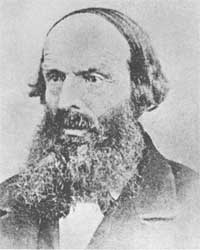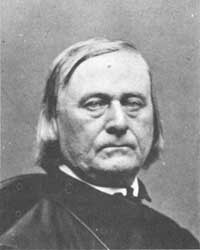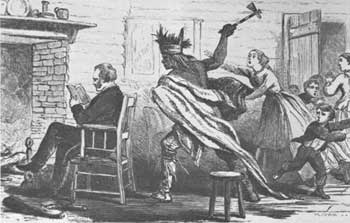





Historical Background
For three decades prior to 1860, missionaries had been filtering into the West to try converting the natives to Christianity. Some, like Father Pierre Jean De Smet, wandered from tribe to tribe. Others, like the Spaldings, the Whitmans, and the Lees, established fixed missions. The Indians usually liked the missionaries. A few even embraced Christianity. But they did so without surrendering old spiritual beliefs. Most of them found nothing in consistent in the adoption of at least the outward forms of as many different religions as promised to be of some value. Aside from enormous changes in material culture, therefore, the Indian's basic values, beliefs, customs, and habitat remained largely intact in 1860.
 |
 |
| Catholic and Protestant missionaries brought the word of God to the Indians, but few were able to bridge the wide cultural gap. Left, Rev. Henry H. Spalding, Protestant. Right, Father Pierre Jean De Smet, Catholic. (Oregon Historical Society (left), Library of Congress (right)) | |
To this generalization there was one important exception. The Five Civilized Tribes of Indian Territory (later Oklahoma)—Cherokee, Creek, Choctaw, Chickasaw, and Seminole—had resolved, even before their forced migration from the East in the 1830's, to pattern their material culture after the white man. They retained their Indian identity, but by 1860 very much resembled him in economic, political, religious, and social forms. Even though land remained in tribal ownership, they had become sedentary farmers and businessmen. They were literate, and they saw important benefits in schools and Christian churches. And they had devised a political system based on U.S. constitutional principles. Like the Pueblos of the Southwest, the Civilized Tribes, after removal from the East, were not an effective part of the Indian barrier to westward expansion.
 |
| Authors and journalists usually portrayed Indians in evil terms. This illustration, from Frances F. Victor's River of the West (Hartford, 1870), presents an imaginative interpretation of the Whitman Massacre. (Denver Public Library, Western Collection) |
 |
 |
http://www.cr.nps.gov/history/online_books/soldier-brave/intro4.htm
Last Updated: 19-Aug-2005